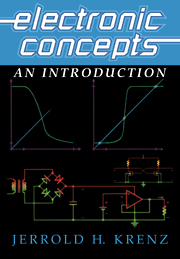Book contents
- Frontmatter
- Contents
- Preface
- 1 ELECTRONIC SYSTEMS: A CENTURY OF PROGRESS
- 2 THE SEMICONDUCTOR JUNCTION DIODE: THE BASIS OF MODERN ELECTRONICS
- 3 THE BIPOLAR JUNCTION TRANSISTOR: AN ACTIVE ELECTRONIC DEVICE
- 4 THE METAL-OXIDE FIELD-EFFECT TRANSISTOR: ANOTHER ACTIVE DEVICE
- 5 NEGATIVE FEEDBACK AND OPERATIONAL AMPLIFIERS
- 6 ELECTRONIC POWER SUPPLIES
- APPENDIX A FABRICATION OF INTEGRATED CIRCUITS
- APPENDIX B THE DESIGN PROCESS
- Index
APPENDIX B - THE DESIGN PROCESS
Published online by Cambridge University Press: 05 June 2012
- Frontmatter
- Contents
- Preface
- 1 ELECTRONIC SYSTEMS: A CENTURY OF PROGRESS
- 2 THE SEMICONDUCTOR JUNCTION DIODE: THE BASIS OF MODERN ELECTRONICS
- 3 THE BIPOLAR JUNCTION TRANSISTOR: AN ACTIVE ELECTRONIC DEVICE
- 4 THE METAL-OXIDE FIELD-EFFECT TRANSISTOR: ANOTHER ACTIVE DEVICE
- 5 NEGATIVE FEEDBACK AND OPERATIONAL AMPLIFIERS
- 6 ELECTRONIC POWER SUPPLIES
- APPENDIX A FABRICATION OF INTEGRATED CIRCUITS
- APPENDIX B THE DESIGN PROCESS
- Index
Summary
The design process cannot be readily characterized. That is, there is not a set of step-by-step rules by which a successful design can be realized. Furthermore, even after a design that satisfies all requirements is completed, it may be difficult to judge whether it is indeed optimal. It is not uncommon at a project's completion for those involved to express the thought that if only they had done it another way, it would have been so much easier – the benefit of hindsight.
When discussing design, we often think in terms of large, complex systems. But the design of such a system might be the result of an individual's intense effort spanning several years such as the development of wide-band frequency modulated broadcasting by Armstrong in the 1930s (Armstrong 1940). Alternatively, a design might be the result of the intense effort of a team of scientists and engineers as was, for example, the design of the compact audio disc, which was the joint effort of two normally competing corporations, Sony and Philips, on opposite sides of the world (Miyaoka 1984). A large design project, however, involves solving many small design problems – problems that at first glance may seem to be trivial but on carrying out the design prove to be otherwise. At times, an overall design may need to be modified because one or more of its components cannot be realized.
- Type
- Chapter
- Information
- Electronic ConceptsAn Introduction, pp. 434 - 450Publisher: Cambridge University PressPrint publication year: 2000

